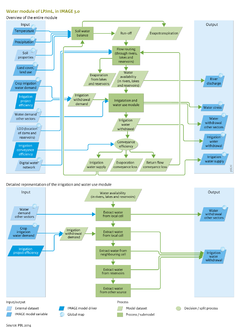Water: Difference between revisions
Jump to navigation
Jump to search
m (Text replace - "FrameworkElementType=model component" to "FrameworkElementType=state component ") |
No edit summary |
||
| Line 1: | Line 1: | ||
{{ComponentTemplate2 | {{ComponentTemplate2 | ||
|ComponentCode=H | |ComponentCode=H | ||
|MainComponent=Vegetation, hydrology and agriculture | |MainComponent=Vegetation, hydrology and agriculture | ||
|InputVar=Land cover; Temperature; Precipitation; Crop irrigation water requirement; Irrigation project and conveyance efficiency; Crop irrigation water requirement; | |FrameworkElementType=state component | ||
|Status=On hold | |||
|Reference=OECD, 2012; Portmann et al., 2010; Fischer et al., 2005;Molden, 2007; FAO, 2011; OECD, 2012; | |||
|InputVar=Land cover; Temperature; Precipitation; Crop irrigation water requirement; Irrigation project and conveyance efficiency; Crop irrigation water requirement; | |||
|OutputVar=Water availability; Irrigation water supply; Run off; River flow; Digital water network; | |||
|Parameter=Soil and vegetation characteristics; Water demand other sectors; | |Parameter=Soil and vegetation characteristics; Water demand other sectors; | ||
| | |Description=Water plays an important role in many natural and human processes. Its availability is essential for natural vegetation and agricultural production, for human settlements and industry. Around one third of the worlds’ population is living in countries already suffering from ‘medium’ to ‘high’ water stress ([[OECD, 2012]]). This number is expected to increase further, due to a growing population that will need more water and is living in a changing climate. | ||
Today, agriculture is responsible for 70% of the total global water withdrawals and is thus by far the biggest water user. Around one third of the total global crop production is harvested from irrigated areas, although they only occupy 17% of croplands (e.g. [[Portmann et al., 2010]]). This indicates that irrigation generally supports more productive agricultural practices. | |||
To meet a growing food demand (see Section 4.2), irrigation is expected to expand in the future ([[Fischer et al., 2005]]; [[Molden, 2007]]; [[FAO, 2011]]) and, hence, will increase agricultural water demand. Moreover, the water demand in other sectors (domestic, electricity, manufacturing) is projected to increase strongly, over the coming decades ([[OECD, 2012]]). As a consequence, competition between different water users will increase and resulting water shortages may affect future food production. | |||
Although the total amount of fresh water on earth is more than enough to fulfil all human needs, it is the uneven distribution that makes water a scarce resource in some regions and watersheds. Climate change will lead to changes in precipitation patterns and, therefore, will also alter the future availability of water, adding to water stress in areas where precipitation levels are expected to decline. | |||
To identify current and future areas of water stress, IMAGE now includes a hydrological model that calculates both water availability and demand. The hydrological module of LPJmL, coupled to the IMAGE model, is fully integrated with terrestrial carbon and land-use dynamics, and calculates agricultural water demand as well as water availability and withdrawals. Availability of renewable water is the net result of precipitation, interception and evapotranspiration by plants and soils. In the model, the surplus in each grid cell is flowing to neighbouring grid cells within a watersheds by means of a river routing scheme. River flows are modified by dams and reservoirs for irrigation, hydropower production or a mix of the two. The effects of water stress on crop production can be quantified by limiting the amount of available water for irrigation to the actually available amount of water in the [[LPJmL model]]. By including the feedback of water-limited crop production on land allocation, IMAGE is able to develop more realistic scenarios for cropland expansion and agricultural intensification in the future. The IMAGE model and the LPJmL model are fully and dynamically coupled (see Section 6.1), and IMAGE scenarios therefore include an integral assessment of the water cycle, and can be used to assess water availability and water demand at high spatial (0.5 x 0.5 degree grid cells) and daily resolutions. | |||
}} | }} | ||
Revision as of 18:16, 9 December 2013
| Component is implemented in: |
|
| Related IMAGE components |
| Projects/Applications |
| Key publications |
| References |
Key policy issues
- What is the combined effect of climate change and socio-economic development on water demand and availability, and on associated agricultural production?
- What is the potential of adaptation measures to reduce water stress and water-related crop production losses?
- How can water demand be reduced and still provide the adequate service levels to the sectors with the highest demand?
